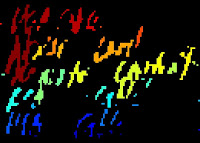We make use of an assembly of three different kinds of bird seeds: small round seeds, white squash seeds and large reddish-brown seed.

The parameters that were took into account were the size of the seeds and their red color channel values. The graph below summarizes the objects parameter's qualities:

The red colored dot stands for the mean value of the small round seed, the blue for the white squash seed and the blue for the large reddish-brown seed. It can be seen that similar objects are clustered together, save for a few deviations in color, which is between the class of the small round seeds and the white squash seeds. The color discrepancy may be attributed to the uneven illumination of the objects when the image was taken. However, the sizes of the two smaller seeds are somehow distinct from each other, so we can still infer the class the correctly belong to. The largest seeds are very far apart from the other two classes in terms of size, so the somehow large deviations from the mean does not matter.
I will give myself a grade of 10/10 for this activity since the code has successfully classified the objects. I would like to thank Earl for his assistance in data collection and help in the code.




















































































